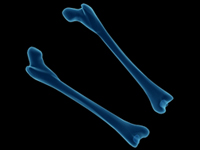
 An all-too-common condition of osteoporosis in post-menopausal women (and older men) has had an equally common treatment since 1995.
An all-too-common condition of osteoporosis in post-menopausal women (and older men) has had an equally common treatment since 1995.'Dead Jaw' syndrome, or Osteonecrosis of the Jaw (ONJ) is a serious bone condition affecting the lower jaw area. Healing of the bone tissue after minor traumas, such as dental extractions, is inhibited. Swelling of the jaw could loosen teeth, and infections could develop. Antibiotic therapy could be long, and sometimes surgery is required to remove dead bone tissue in the jaw.
In addition to the treatment of osteoporosis, biophosphonates have been used to treat cancer patients for the past 15 years. Three years ago, the United States Food and Drug Administration (FDA) and drug manufacturer Novartis issued warnings in September 2004 regarding the potential for the onset of ONJ stemming from the use of bisphosphonates in chemotherapy patients. Cancer patients are administered a more potent version of the drug, usually intravenously, and this is the group shown to be at greatest risk: well over two thousand reports of ONJ since 2001.
However, there have also been similar reports from an admittedly smaller group - 120 - representing those who take bisphosphonates in pill form, such as Fosamax. A study published in the Journal of Oral and Maxillofacial Surgeons made the connection between ONJ and Fosamax, regardless of dosage.
Fay Sedore had been taking Fosamax for three years after suffering a fracture in her foot. It was then that she began having problems with her teeth, gums and jaw - including loose teeth. The forty-something woman had always enjoyed pristine dental health until Fosamax. Her doctor tried to explain away her jaw trouble as a rare condition, and not necessarily linked to the Fosamax she had been taking. But Fay did her homework, and is convinced Fosamax has given her a wallop like a fist to the jaw.
A discomforting side issue is that with many patients developing ONJ and infections of the jaw, their dentists seemed to have a greater awareness of the Fosamax risk than the medical community - especially prior to the FDA warning in 2004.
For its part, Merck & Co. makes no reference on the Fosamax web site about ONJ. Beyond the usual disclaimers against inappropriate or ill-advised use given the presence of various prior conditions, side effects listed include things like nausea, indigestion, fatigue and trouble swallowing.
The only reference to bone tissue, as of May 2nd 2007, is a warning to call a doctor if a patient begins to notice severe bone, joint and/or muscle pain of any kind.
However, there is a statement posted on the Merck & Co. home page, which addresses the ONJ issue. In it, the company admits that while reports of ONJ in patients taking Fosamax are rare, controlled clinical trials involving some 17,000 patients over a 10-yerar period produced zero reports of ONJ.
The FDA warning in 2004 did not name Fosamax, and was instead directed to more potent forms of bisphosphonates delivered to the patient intravenously. However, while the warning did not address milder forms of bisphosphonates like Fosamax, many researchers have suggested the potential for similar side effects.
Patients like Sophie Lewis (not her real name) bear that out. She was on Fosamax for a year before experiencing tremendous pain in her jaw - pain that has now become chronic. She estimates she has spent $25,000 to relief her suffering. Suffering she attributes to Fosamax.
READ MORE LEGAL NEWS
Lawsuits filed against Merck, the makers of Fosamax, claim that information pertaining to the association of Fosamax with osteonecrosis of the jaw was known to the manufacturer, but that Merck dropped the ball when it came to sharing that risk with consumers.
Fosamax has been prescribed to ten million women and men since its introduction, with 191 million prescriptions written. Bracing for an onslaught of litigation, Merck has set aside a U.S. $48 million defence fund.
